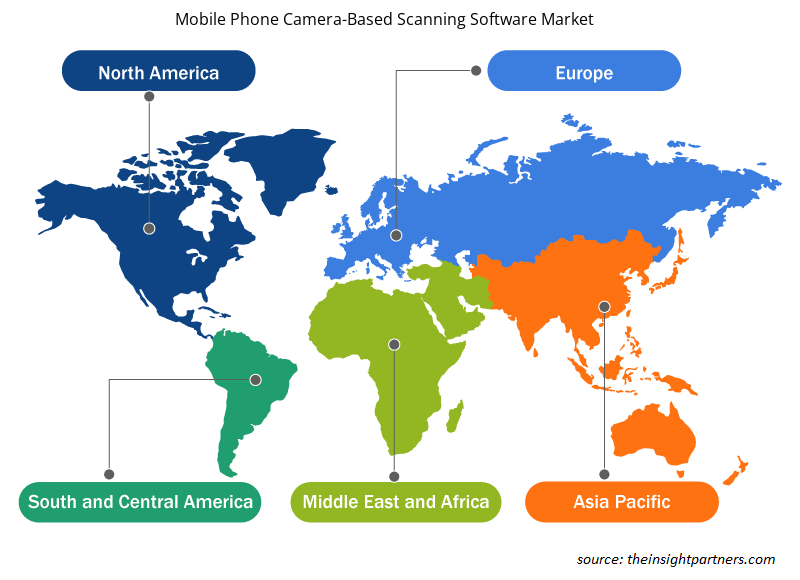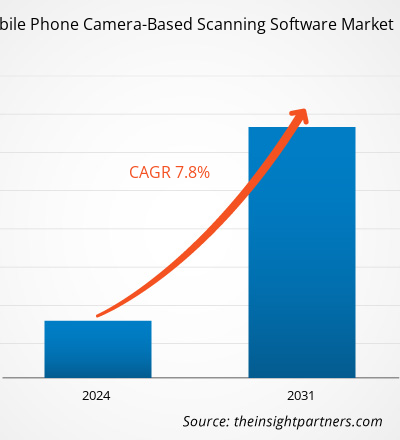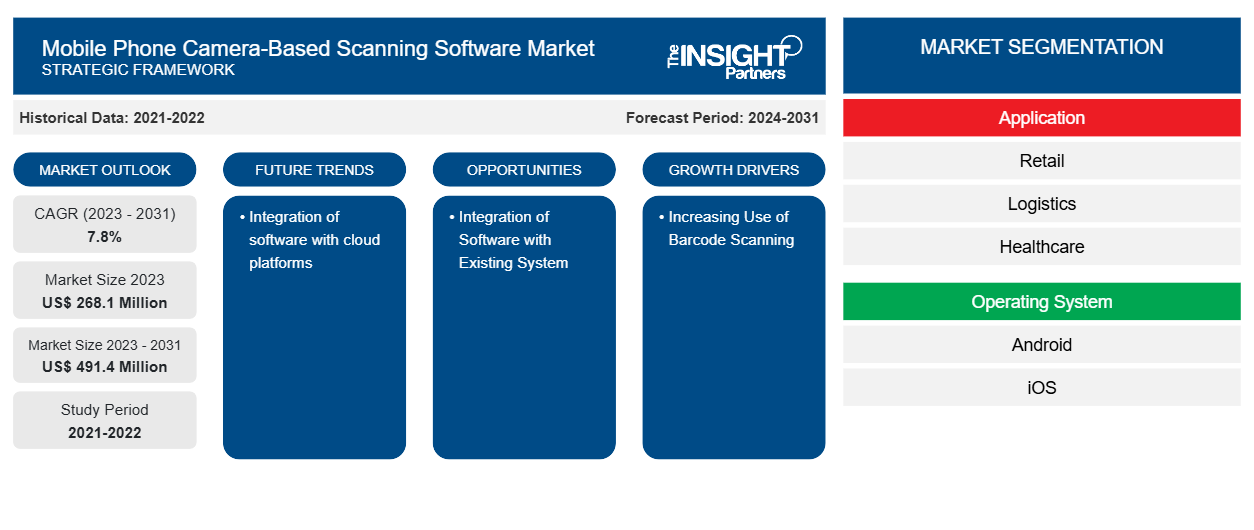携帯電話カメラベースのスキャン ソフトウェア市場規模は、2023 年の 2 億 6,810 万米ドルから 2031 年には 4 億 9,140 万米ドルに達すると予測されています。市場は 2023 年から 2031 年にかけて 7.8% の CAGR を記録すると予想されています。ソフトウェアとクラウド プラットフォームの統合は、今後も市場の主要なトレンドであり続けると思われます。
携帯電話カメラベースのスキャンソフトウェア市場分析
スキャン ソフトウェアは、従来のハードウェア バーコード スキャナーに比べて多くの利点を提供し、企業の運営方法を変える準備が整っています。ソフトウェア ベースのスキャン ソリューションを採用することで、企業は効率を高め、精度を向上させ、貴重な洞察を得ることができ、最終的には成長と成功につながります。バーコードスキャン ソフトウェアは、小売業を含むさまざまな業界に革命をもたらし、在庫管理、製品追跡、チェックアウト プロセスを合理化しました。物流では、データ収集の自動化、出荷の追跡、倉庫業務の最適化が実現します。医療では、患者の識別、投薬管理、医療記録管理を強化します。
携帯電話カメラベースのスキャンソフトウェア市場の概要
バーコード スキャン ソフトウェアは、ソフトウェア アルゴリズムを使用して、デジタル カメラやモバイル デバイスで収集されたバーコードをデコードします。専門的な機器が必要なハードウェア バーコード スキャナーとは異なり、バーコード ソフトウェア ソリューションは現在のデバイスやアプリケーションに統合できるため、柔軟性が高く、コストを節約できます。スキャン ソフトウェアは、一般にバーコード スキャナー API、または単にバーコード API と呼ばれます。バーコード スキャン ソフトウェアは、従来のハードウェア バーコード スキャナーに比べて多くの利点があります。柔軟性があり、ソリューションはさまざまなスキャン シナリオやカメラ構成に合わせて簡単に調整できるため、さまざまなアプリケーションに適しています。ソフトウェアによって特殊なハードウェアが不要になるため、初期費用が削減されます。さらに、スキャン ソフトウェア ソリューションは、メンテナンスと更新が最小限で済むことが多いため、長期的なコストが削減されます。
要件に合わせてレポートをカスタマイズする
このレポートの一部、国レベルの分析、Excelデータパックなど、あらゆるレポートを無料でカスタマイズできます。また、スタートアップや大学向けのお得なオファーや割引もご利用いただけます。
- このレポートの主要な市場動向を入手してください。この無料サンプルには、市場動向から見積もりや予測に至るまでのデータ分析が含まれます。
携帯電話カメラベースのスキャンソフトウェア市場の推進要因と機会
市場を有利にするバーコードスキャンの利用増加
手作業によるデータ入力に依存している企業、倉庫、その他の施設では、人為的ミスの発生率が高くなっています。手作業でデータを入力する従業員は、数字を逆にしたり、行を飛ばしたり、数字を誤解したり、他の人が読めないようなひどい字を書いたりする可能性が非常に高くなります。一方、バーコードを使用すると、人為的ミスの可能性が大幅に低減し、ほぼゼロになります。バーコード スキャンは、手作業によるデータ入力よりも効率的で信頼性が高く、時間がかかりません。在庫保管コストの削減に苦労している企業も、バーコード プログラムを実装することでメリットを得られます。バーコードを使用すると、企業は在庫をリアルタイムで更新でき、正確な更新が即時に行われ、実際の在庫数が示されます。在庫数が正確になれば、配送時間、在庫コストの定義、市場価格の引き上げが可能になるため、効率が向上します。そのため、バーコードの使用が増え、カメラ ベースのバーコード スキャン ソフトウェアの成長が促進されます。
既存システムとソフトウェアの統合
携帯電話のカメラ ベースのスキャン ソフトウェアは、データの収集、処理、既存のシステムやソフトウェアとの統合など、従来のバーコード スキャンを超えるさまざまな機能と性能を備えています。中央データベースとデータを同期したり、POS システムや在庫管理ソフトウェアと通信したり、ワイヤレスで情報を転送したりして、リアルタイムの更新と正確性を確保できます。このソフトウェアは、在庫管理ソフトウェア、POS (販売時点管理) システム、顧客関係管理 (CRM) ソフトウェア、エンタープライズ リソース プランニング (ERP) システムなどの既存のシステムとシームレスに統合するようにカスタマイズまたは開発できます。この互換性により、企業は既存のソフトウェア インフラストラクチャを活用して、運用効率を可能な限り最適化できます。したがって、既存のシステムとの統合により、マーカーの成長の機会が生まれます。
携帯電話カメラベースのスキャンソフトウェア市場レポートのセグメンテーション分析
携帯電話のカメラベースのスキャン ソフトウェア市場分析の導出に貢献した主要なセグメントは、アプリケーションとオペレーティング システムです。
- アプリケーションに基づいて、携帯電話カメラベースのスキャン ソフトウェア市場は、小売、物流、ヘルスケア、ホスピタリティ、郵便、その他に分類されます。
- オペレーティング システムの観点から見ると、市場は Android と iOS に分割されています。
携帯電話カメラベースのスキャンソフトウェア市場シェアの地域別分析
携帯電話カメラベースのスキャン ソフトウェア市場レポートの地理的範囲は、主に北米、アジア太平洋、ヨーロッパ、中東およびアフリカ、南米および中米の 5 つの地域に分かれています。北米は、さまざまなソフトウェア開発者やデジタル ソリューション プロバイダーが存在する先進国です。北米全域の企業は、ソフトウェアとデジタル ソリューションを採用しています。スマートフォン技術の開発は地域全体でより洗練されつつあり、より多くの開発者がスマートフォンの機能を高めようとしています。そのような機能の 1 つは、カメラ技術を画像キャプチャ デバイスとしてだけでなく、生産性を向上させるスキャナー代替デバイスとして使用することです。
携帯電話カメラベースのスキャンソフトウェア市場の地域別分析
予測期間を通じて携帯電話カメラベースのスキャン ソフトウェア市場に影響を与える地域的な傾向と要因は、Insight Partners のアナリストによって徹底的に説明されています。このセクションでは、北米、ヨーロッパ、アジア太平洋、中東およびアフリカ、南米および中米にわたる携帯電話カメラベースのスキャン ソフトウェア市場のセグメントと地理についても説明します。

- 携帯電話カメラベースのスキャンソフトウェア市場の地域別データを入手
携帯電話カメラベースのスキャンソフトウェア市場レポートの範囲
| レポート属性 | 詳細 |
|---|---|
| 2023年の市場規模 | 2億6,810万米ドル |
| 2031年までの市場規模 | 4億9,140万米ドル |
| 世界のCAGR(2023年~2031年) | 7.8% |
| 履歴データ | 2021-2022 |
| 予測期間 | 2024-2031 |
| 対象セグメント | アプリケーション別
|
| 対象地域と国 | 北米
|
| 市場リーダーと主要企業プロフィール |
|
携帯電話カメラベースのスキャンソフトウェア市場のプレーヤー密度:ビジネスダイナミクスへの影響を理解する
携帯電話カメラベースのスキャン ソフトウェア市場は、消費者の嗜好の変化、技術の進歩、製品の利点に対する認識の高まりなどの要因により、エンド ユーザーの需要が高まり、急速に成長しています。需要が高まるにつれて、企業は提供内容を拡大し、消費者のニーズを満たすために革新し、新たなトレンドを活用し、市場の成長をさらに促進しています。
市場プレーヤー密度とは、特定の市場または業界内で活動している企業または会社の分布を指します。これは、特定の市場スペースに、その市場規模または総市場価値に対してどれだけの競合相手 (市場プレーヤー) が存在するかを示します。
携帯電話カメラベースのスキャンソフトウェア市場で事業を展開している主要企業は次のとおりです。
- スキャンディット
- 株式会社リオテック
- グラバ
- マーソンテクノロジー株式会社
- コアムタック
- コグネックス株式会社
免責事項:上記の企業は、特定の順序でランク付けされていません。

- 携帯電話カメラベースのスキャンソフトウェア市場のトップキープレーヤーの概要を入手
携帯電話カメラベースのスキャンソフトウェア市場のニュースと最近の開発
携帯電話カメラベースのスキャン ソフトウェア市場は、主要な企業出版物、協会データ、データベースなどの一次調査と二次調査後の定性的および定量的データを収集することによって評価されます。携帯電話カメラベースのスキャン ソフトウェア市場におけるいくつかの開発を以下に示します。
- モバイル コンピューター ビジョンと拡張現実 (AR) 向けのエンタープライズ テクノロジー プラットフォームである Scandit は、マルチキャリア配送ソリューションである Consignor が Scandit のバーコード スキャナー SDK を新しい Scan App Pro に統合し、比類のないバーコード ライブラリを使用して高速で信頼性の高いスキャンを可能にしたことを発表しました。(出典: Scandit、2021 年 2 月)
- 企業向けモバイルコンピュータビジョンおよび拡張現実(AR)ソリューションの大手テクノロジープラットフォームであるScanditは、食料品小売業者のMAXIMAがバーコードスキャナSDKをMAXIMAモバイルアプリに統合し、エストニア全土の84店舗の顧客がスマートフォンを使用してセルフスキャンショッピングを行えるようになったと発表しました。(出典:Scandit、2021年6月)
携帯電話カメラベースのスキャンソフトウェア市場レポートの対象範囲と成果物
「携帯電話カメラベーススキャンソフトウェア市場規模と予測(2021〜2031年)」レポートでは、以下の分野をカバーする市場の詳細な分析を提供しています。
- 携帯電話カメラベースのスキャンソフトウェア市場の規模と予測、および対象範囲に含まれるすべての主要市場セグメントの世界、地域、国レベルでの予測
- 携帯電話カメラベースのスキャンソフトウェア市場の動向、および推進要因、制約、主要な機会などの市場動向
- 詳細なPEST/ポーターの5つの力とSWOT分析
- 携帯電話のカメラベースのスキャンソフトウェア市場分析では、主要な市場動向、世界および地域の枠組み、主要プレーヤー、規制、最近の市場動向を取り上げています。
- 携帯電話カメラベースのスキャンソフトウェア市場における市場集中、ヒートマップ分析、主要プレーヤー、最近の動向を網羅した業界展望と競争分析
- 詳細な企業プロフィール
- 過去2年間の分析、基準年、CAGRによる予測(7年間)
- PEST分析とSWOT分析
- 市場規模価値/数量 - 世界、地域、国
- 業界と競争環境
- Excel データセット
最新レポート
関連レポート
お客様の声
購入理由
- 情報に基づいた意思決定
- 市場動向の理解
- 競合分析
- 顧客インサイト
- 市場予測
- リスク軽減
- 戦略計画
- 投資の正当性
- 新興市場の特定
- マーケティング戦略の強化
- 業務効率の向上
- 規制動向への対応





















 無料サンプルを入手 - 携帯電話カメラベースのスキャンソフトウェア市場
無料サンプルを入手 - 携帯電話カメラベースのスキャンソフトウェア市場